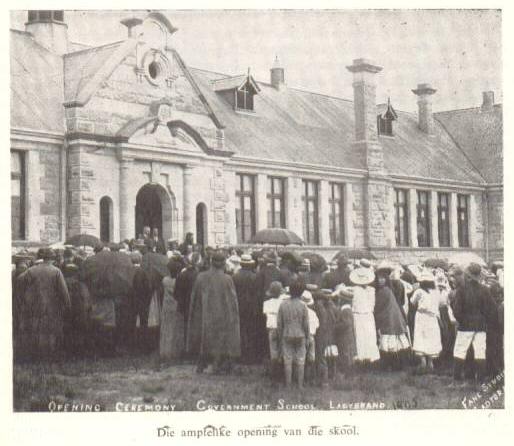HISTORY OF OUR SCHOOL
The first school in Ladybrand was founded in 1872 under the leadership of a reverend of the Dutch Reformed church, the Reverend Louis Hugo. The church building was used as a school.
In approximately the same time, several private schools were started. The government did, however, assist these schools financially, but the parents were responsible for the remuneration of the teachers.
Mr Davis, a Scottish citizen, was one of the teachers from the pioneer’s era. He believed in corporal punishment and did not spare the rod at his school. This caused him to be transferred very soon. Mr Cury started a private school at the Grand Hotel.
This was how education in the 70s struggled. The church and the state worked together since 1872. An ordinance was promulgated to appoint a district and ward school commissions.
It was decided to establish a “gouvernementschoolgebouw” for the town in 1874. It was accomplished two years later and the new school was formally opened with 32 learners. Mr A H cn Buren-Schele was the first principal, assisted by Miss Sannie van Blerk. The school had one class room only in which the principal and the assistant had to teach simultaneously.
The number of learners increased consistently. There were 39 learners in 1877. An English assistant was appointed in that time. The school role increased due to the fact that school attendance became compulsory as from 1897.
The war that broke out on 11 October 1899 had devastating effects on educational activities in the town and the school had to be closed temporarily.
After the English occupation of the town in 1890, Mr Daan van Soelen was requested to re-open the school. This was a difficult task seeing that the school was turned into a hospital. The room or the Kinder garden section were used for prisoners of war and for people who were on the black list of the enemy. The hospital was evacuated in 1902 and education could proceed.
The new rulers had one goal and that was to anglicize the Afrikaner children. Three thousand teachers were brought from England. All subjects were presented in English. During photo sessions, only the names of the English teachers were allowed on official photos.
Under the leadership of Mr McDonnald, a new school was built in 1904 and learners could progress to matric for the first time. The school role increased dramatically as seen from a report by an inspector, Mr Robt Bowie, dated 13 July 1907: “The history of this school is somewhat unique.”

Several prominent figures started their school careers in Ladybrand
Mr L. van Zyl was appointed Inspector of Schools in 1921. He became Secretary of Education and later became Provincial Secretary of the Free State.
Mr CP Venter became principal of the “Sentrale Hoërskool” after which he was appointed Inspector and Head Inspector of Education.
The 1920 matric class consisted of three boys and a girl, all of whom were older than the principal, Mr Venter, who was 19 years old. The oldest learner was in standard nine. He was 24 years old and eventually made matric.
A debating committee was started in 1920. The first issue of the Annual Book/Report was published. The school song was written by the late Mr Martyn du Plessis. It was composed by the gifted organist of the Dutch Reformed Church, Mr Tommy Matthews, who was blind.
Mr CJ Kleijn became principal at the High School in January 1963. Many achievements were reached during his reign of three years and six months.
